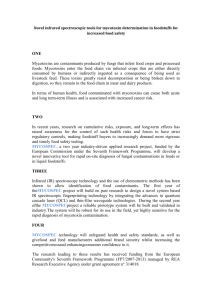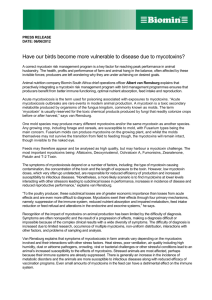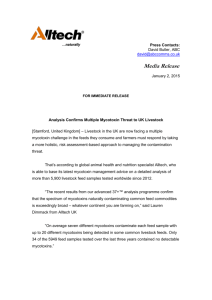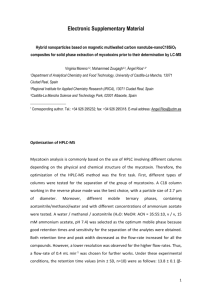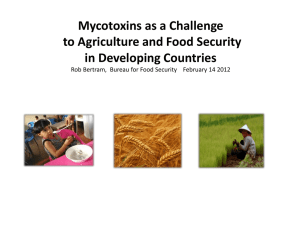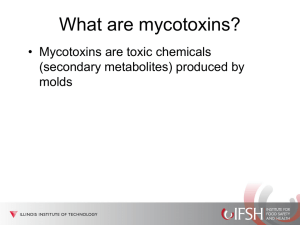mycotoxins - Animal Sciences
advertisement
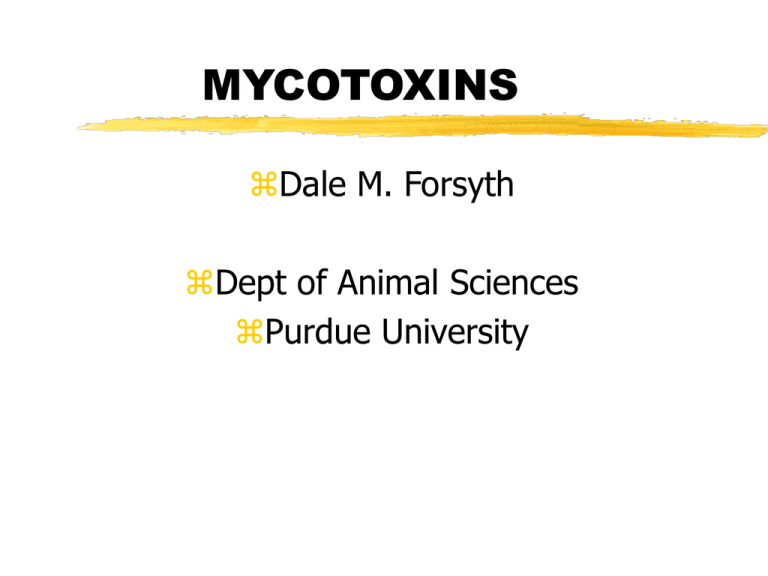
MYCOTOXINS Dale M. Forsyth Dept of Animal Sciences Purdue University MYCOTOXINS Toxins produced by fungi Metabolic products or by-products of fungi (molds) Why Great Concern? Some mycotoxins are DEADLY at very small dosages. Some mycotoxins are carcinogenic. Some mycotoxins cause huge losses in productivity in animals. Most fungi do not produce Mycotoxins Many fungi are edible Mushrooms are fungi Moldy feeds may be degraded without presence of mycotoxin, or may be unaffected in value. some material courtesy of Mark Diekman DIPLODIA Infested Corn Specie Diet Rat Autoclaved Diplodia Autoclaved Diplodia Autoclaved Diplodia 31.8 30.3 2.27a 1.87b 7.19a 4.43b 12.0a 11.0b 28.2a 25.7b 12.0 11.6 3.70 4.88 26.3 27.3 Autoclaved Diplodia 203.4b 286.5a 5.16 4.76 6.82b 4.60a Mouse Hamster Guinea pig Wkly gain, g Feed, % F/G of BW Effect of fungus Damage on Digestibility of Corn by Rats Item Sound Diplodia Sound Fusarium zeae Moniliforme Energy studies Dig. Energy,% 90.7 89.4 91.0 89.5 Body Wt gain 100 95 100 81 83.6 81.2 81.9 75.0 Protein studies Dig. Nitrogen,% (Corn essentially 100% Fungus damaged) Mitchel & Beadles, 1940 Feeds Most Susceptible to Fungi-producing Mycotoxins Corn Wheat Oats Barley Recently Sorghum Cottonseed Peanut meal Rye Moldy grain is usually nontoxic Competition between toxic and nontoxic molds. Entire mold population is not producing mycotoxin Conditions for growth are different for mold growth vs mycotoxin production Molds that attack grain can: Decrease grade Kernel damage odor Decrease Decrease Decrease Decrease milling quality seed germination dry matter feeding value (sometimes) Mycotoxins can cause: Death Poor performance from low FI, ADG Respiratory problems Reproductive problems Liver, kidney or other organ damage Cancer Mycotoxins Factors causing variation in effects Species, breed Age Sex Nutritional status Other diseases Other mycotoxins Extent of exposure Some mycotoxins are formed in the field, some in storage Storage conditions that favor production of mycotoxins: Temperature (40 - 90o F ; 4 - 32o C) Relative Humidity (> 70%) Moisture (22-23% in grain) Oxygen (1-2%) MOST COMMON MYCOTOXINS in the USA DEOXYNIVALENOL (vomitoxin) Fusarium ZEARALENONE (Gibberella) AFLATOXIN - Aspergillus flavus FUMONISON - Fusarium moniliforme ERGOT (ergotamine, dihydroergosine) Claviceps Trichothecene Mycotoxins Nivalenol Deoxynivalenol T-2 toxin HT-2 toxin Diacetoxyscirpenol Triacetoxyscirpendiol Fusarenone X Verrucarin A, B, J Roridin A, D, E, H Many Others (29+) These are “field” toxins, not “storage” toxins Other Mycotoxins of Growing Interest Ochratoxins Produced by Penicillium verrucosum and several spp. Of Asperfillus. Potently nephrotoxic and carcinogenic, teratogenic and immunotoxic. Public health problem, but little evidence of problematic instances in swine. Other Common Molds Penicillium Common blue mold Capable of producing mycotoxin, usually does not. Diplodia Affected cattle and sheep in Africa Organisms - 1 Fusarium Taxonomy is quite confusing Has had classification changed various times Fusarium roseum, Fusarium graminearum and Gibberella zeae are all terms applied to the same thing. Gibberella zeae is the “perfect” (reproductive) stage Nickname “GIB” corn. Fusarium toxins Deoxynivalenol Feed refusal Emesis (so nicknamed “vomitoxin”) Zearalenone Estrogenic effects Deoxynivalenol Feed refusal factor for pigs. Emetic (vomiting) but seldom see pigs vomiting, refuse feed Deoxynivalenol - Feed Refusal Nearly complete refusal at low dosages (~5 ppm) by swine. Reduced intake and poor performance at very low dosages (~1 ppm or less) Other animals much much less affected! DON doesn’t account for all the refusal, other metabolites are involved (though seldom tested for). DON Does Not affect Reproduction Purified Deoxynivalenol DON, ppm CL's Fetuses 0 13.2 10.0 2 14.2 11.7 4 13.0 9.2 8 13.7 11.0 Field conditions that favor Gib fungus Cool, wet weather at silking time Slow drying weather at harvest Varieties with tight husks Recovery of DON-infected CORN DON is very stable! Heat, chemicals, etc. have no effect. DON is water soluble! So, can be leached out and washed away. Not too practical, so Advice: feed to other animals instead. Guidelines on Levels FDA guidelines on DON in feeds 10 ppm in grains, by-products for chickens & cattle (5 ppm total ration) 5 ppm in ingredients for swine max inclusion rate 20% (1 ppm total ration) 5 ppm ingredients max inclusion 40% (2 ppm) all other animals Canada: 1 ppm pigs, calves, lambs, lactation. 5 ppm adult cattle, sheep, poultry Zearalenone Prepuberal gilts show enlarged, swollen vulva as if in estrus Interrupted reproductive cycles in female swine Prolapse of the vulva possible Lengthened or absent estrous cycle Little or no effect on growth Little effect of Z on growth ZEN GAIN FEED INTAKE F/G 0 10 20 40 10.3 10.7 11.0 12.2 .75 .75 .81 .82 .49 .51 .49 .53 Initial wt 10 kg, fed 4 wk. James & Smith (1982) Organisims - 2 Aspergillus spp. - Especially A. flavus Also A. parasiticus and Penicillium puberulum. Soil organism (A. flavus), so quite common, especially in peanuts. CAN produce AFLATOXIN AFLATOXIN is probably the worst common mycotoxin we deal with. AFLATOXIN Most references to “mycotoxin”, unspecified, refer to Aflatoxin. There is NO reason to assume similarities with other mycotoxins, in any regard. Can be deadly at low dosages In 1st outbreaks (~1960) 100,000 turkeys died + many ducks. Associated with “groundnut” (peanut) meal Aflatoxin (cont) Occurs in corn and other grains also. Temperature > 12 C (54 F) and high humidity (83% at 30 C). Therefore usually a bigger problem in USA in South and Southeast. Hepatic toxin - zonation, biliary proliferation, degeneration. Carcinogenic in chronic situations. AFLATOXIN EFFECTS Inhibits protein synthesis Poor gain Liver damage Susceptibility to Infection Residues / carcinogenicity Reproduction in swine not primarily affected Aflatoxin on Performance Growing Swine (53 Kg initial) PPB Final Wt, Kg 20 104 385 97 750 91 1480 80 ADG (Kg) .77a .67b .57b .41c F/G 3.74a 3.78a 3.71a 3.97 Aflatoxin (cont) A few of many Aflatoxins Aflatoxin Detection Black Light test - BYG fluorescence Abused. Use very carefully by trained people Presumptive test for organism, not aflatoxin Many other things fluoresce, including broken soybean seeds Chromatography Including rapid minicolumn in-field tests Dealing with AFLATOXIN FDA ACTION level is 20 ppb Small amount may contaminate huge quantities Strategies to decontaminate must have FDA approval in USA. Some methods, however, can lower aflatoxin levels. DECONTAMINATION Cleaning, separation, sorting AMMONIATION Binding Agents Sodium aluminosilicate and hydrated sodium calcium aluminosislicate NOT GRAS for binding mycotoxins. MUCH BETTER TO PREVENT FORMATION Preventing Mycotoxins Use “clean” procedures. Prevent contamination Inhibit mold growth Drying Refrigeration Mold inhibitors Additional Mycotoxins FUMONISON Deadly to horses equine leukoencephalomalacia Swine - pulmonary oedema Renal toxicity and hepatotoxic FUMONISON Actually 8 analogs known, only B1, B2 & B3 often found. ORGANISM is Fusarium moniliforme [=F. verticillioides (Sacc.) Nirenberg] or F. proliferatum Fusarium moniliforme is VERY COMMON but seldom produces mycotoxin. Fumonison - Levels < 5 ppm for Horses 10 ppm for swine 50 ppm for cattle ERGOT Traditionally, this is a disease of RYE and other small grains. New threat in Grain Sorghum (milo) to Western Hemisphere. Has been prevalent in Africa for decades (claviceps africana) Has very rapidly spread in last 2 years, now in USA. Sorghum Ergot Pathogen causes ovary to exude a sticky liquid. Dihydroergosine at .6 ppm decreases FI & ADG. Effect appears to be from poor feed intake Dean et al, 1999 Traditional Ergot Claviceps purpurea produces ergotamine and other alkaloids. Psychoactive - convulsions, hallucinations, abortions Paralysis, GI disturbance, gangrene of extremities, death. ADVICE Avoidance of Mycotoxin formation is best in every case Some procedures for decontamination exist (ammonia, HSCAS), but are different for different mycotoxins, may be ineffective and may not be legal. Advice- continued I would: Feed NO moldy feeds to reproducing animals. Feed a small test amount to growers but DO NOT encourage consumption. If no ill effect is observed in test, then dilute the suspect feed and incorporate small amount into normal diet. WWW References to References Australian Mycotoxin Newsletter http://www.aciar.gov.au/aciarptp/myconews.htm Third Joint FAO/WHO UNEP International Conference on Mycotoxins, Mar 1999 http://www.fao.org/WAICENT/FAOINFO/ECONO MICS/ESN/mycoto/papers/
